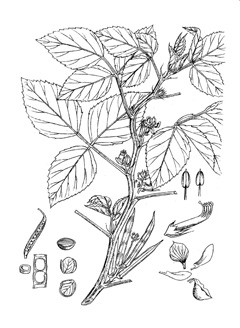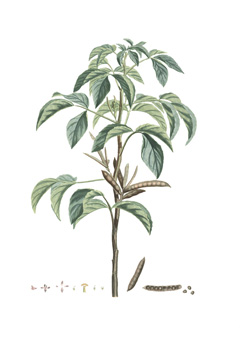 |
|
https://edibleplants.org/ |
 |
| https://edibleplants.org/ |
Translate this page:
Summary
Cluster Bean or Guar (Cyamopsis tetragonoloba) is a legume with a nitrogen-fixing capability due to its symbiotic relationship with certain soil bacteria. It is used in crop rotation to replenish the soil. It is an upright plant that grows up to 3 m in height. The leaves and stems are mostly hairy. The leaves are elongated, oval shaped, and of alternate position. It is often consumed as a vegetable. The seed is the source of guar gum which is used as a stabilizer and thickener in various food and food products. It is also eaten when cooked and possesses medicinal values. It stabilizes blood sugar level, a laxative, and a digestive tonic. The plant is very drought resistant when established.
Physical Characteristics

 Cyamopsis tetragonoloba is an evergreen Perennial growing to 2 m (6ft) by 1 m (3ft 3in) at a fast rate.
Cyamopsis tetragonoloba is an evergreen Perennial growing to 2 m (6ft) by 1 m (3ft 3in) at a fast rate.
See above for USDA hardiness. It is hardy to UK zone 10 and is frost tender. The plant is self-fertile.
It can fix Nitrogen.
Suitable for: light (sandy) and medium (loamy) soils, prefers well-drained soil and can grow in nutritionally poor soil. Suitable pH: mildly acid, neutral and basic (mildly alkaline) soils and can grow in very acid, very alkaline and saline soils.
It cannot grow in the shade. It prefers dry or moist soil and can tolerate drought.
UK Hardiness Map
US Hardiness Map
Synonyms
Cyamopsis psoraleoides (Lam.) DC.
Plant Habitats
Edible Uses
Edible Parts: Leaves Seed Seedpod
Edible Uses: Gum Stabilizer
Leaves - cooked as a vegetable[ 300 ]. Seed - cooked[ 300 ]. Rich in protein[ 301 ]. The seeds can also be sprouted and eaten[ 301 ]. The seeds are about 5mm long[ 300 ]. Seedpods - cooked[ 300 ]. The unripe seedpods are eaten in curries, fried, salted, or dried for later use[ 301 ]. The pods are 4 - 10cm long[ 300 ]. Unripe pods need to be thoroughly cooked in order to destroy a toxic principle[ 200 ]. Only traces of this toxin remain in mature pods[ 200 ]. The seeds are used to make guar gum, which is much used by food manufacturers as a stabilizer and thickener in ice creams, bakery goods, gluten-free foods etc[ 301 ].
References More on Edible Uses
Medicinal Uses
Plants For A Future can not take any responsibility for any adverse effects from the use of plants. Always seek advice from a professional before using a plant medicinally.
Anticholesterolemic Digestive Hypoglycaemic Laxative Tonic
The seeds are dried, ground into a powder then mixed with water to form a viscous substance known as guar gum[ 254 ]. This comprises about 86% water-soluble mucilage consisting of mainly galactomannin[ 254 ]. Guar gum is gently laxative, helps to lower blood cholesterol levels and acts as a digestive tonic[ 254 ]. The gum is taken internally as an effective but very gentle bulk laxative[ 254 ]. It also delays the emptying of the stomach and thereby slows the absorption of carbohydrates, thus helping to stabilize blood sugar levels[ 254 ]. This can be of great importance to people with blood sugar level problems, such as diabetics and pre-diabetics[ 254 ].
References More on Medicinal Uses
The Bookshop: Edible Plant Books
Our Latest books on Perennial Plants For Food Forests and Permaculture Gardens in paperback or digital formats.

Edible Tropical Plants
Food Forest Plants for Hotter Conditions: 250+ Plants For Tropical Food Forests & Permaculture Gardens.
More

Edible Temperate Plants
Plants for Your Food Forest: 500 Plants for Temperate Food Forests & Permaculture Gardens.
More

More Books
PFAF have eight books available in paperback and digital formats. Browse the shop for more information.
Shop Now
Other Uses
Filter Green manure Gum
Agroforestry Uses: Cluster bean is often used as a cover crop, and green manure is used to improve soil fertility through nitrogen fixation. It can also be used in intercropping systems.[ 46 ]. Other Uses: Guar gum, made from the seeds of the plant, has been used as a filter in industry, as a size when making paper and in cosmetics[ 254 ]. Use of guar gum in hydraulic fracturing (oil shale gas). 1. Nectary - Flowers rich in nectar and pollen:
Yes – The flowers of the cluster bean are known to produce nectar and pollen, attracting various pollinators, including bees.
2. Wildlife - Food (Fruit, Seeds, Leaf litter, Shelter, Nesting, Roosting):
Yes, the pods and seeds of cluster beans are edible and provide food for various wildlife. The foliage can also offer some cover, though it is not primarily a bird nesting or roosting site.
3. Invertebrate Shelter (Overwintering sites, Leaf litter, Groundcover):
Yes – The plant can provide habitat for beneficial insects and invertebrates, especially in its leaf litter. Its structure may offer some shelter for various species.
4. Pest Confuser (Smell):
No – Cluster beans are not particularly known for their aromatic properties that would confuse or deter pests.
Special Uses
Food Forest Nitrogen Fixer
References More on Other Uses
Cultivation details
Suitable for growing in the warm temperate zone as an annual, it is more commonly grown in lowland tropical and subtropical areas up to an elevation of 1,000 metres[ 300 ]. Tolerating high temperatures, it requires a high level of solar radiation to do well[ 300 ]. Grows best when the soil temperature is in the range of 25 - 30°c, bur able to tolerate temperatures to 45°c[ 300 , 418 ]. Prefers an annual rainfall in the range of 500 - 800mm, but can tolerate up to 2,700mm[ 300 , 418 ]. Dry weather is essential once fertilization has taken place - the developing pods can be damaged by high humidity or rainfall[ 300 ]. Prefers a sunny position[ 418 ]. Grows best in alluvial and sandy loam soils[ 300 ]. Established plants are very drought resistant[ 300 ]. Some forms are tolerant of poor soils, alkaline or saline conditions[ 300 ]. Prefers a pH in the range 7.5 - 8, tolerating 5.5 - 8.5[ 300 , 418 ]. Young pods can be harvested 2 - 3 months after sowing the seed[ 300 ]. Yields of 6 - 8 tonnes per hectare of the pods have been obtained[ 300 ]. Approximately 800kg of dried seed per hectare is considered average[ 300 ]. There are some named varieties[ 300 , 301 ]. Many cultivars are daylength sensitive, though many new cultivars are daylength neutral[ 300 ]. The plant has a vigorous taproot[ 200 ]. This species has a symbiotic relationship with certain soil bacteria, these bacteria form nodules on the roots and fix atmospheric nitrogen. Some of this nitrogen is utilized by the growing plant but some can also be used by other plants growing nearby[ 200 ]. Cluster bean is self-fertile. The pods are typically harvested in late summer to early autumn when they are young and tender.
Cluster beans flower in mid to late summer. Cluster bean grows quickly, reaching maturity in about 60 to 90 days after planting
References Carbon Farming Information and Carbon Sequestration Information
Temperature Converter
Type a value in the Celsius field to convert the value to Fahrenheit:
Fahrenheit:
The PFAF Bookshop
Plants For A Future have a number of books available in paperback and digital form. Book titles include Edible Plants, Edible Perennials, Edible Trees,Edible Shrubs, Woodland Gardening, and Temperate Food Forest Plants. Our new book is Food Forest Plants For Hotter Conditions (Tropical and Sub-Tropical).
Shop Now
Plant Propagation
Seed - sow 2 - 3cm deep in situ[ 300 ]. Scarification can promote rapid germination, inoculating the seed with Rhizobium may be necessary[ 300 ]. Often they are grown in mixed cropping situations. It requires 15-24 kg of seed to sow a hectare. They are often put 20-30 cm apart in rows 65 cm apart. Seed germinate within one week.
Other Names
If available other names are mentioned here
Cluster Bean or Guar (Cyamopsis tetragonoloba). Also known as: Bakuchi, Bavachi gowar, chavalikayi in Kannada, Dridhabija, javaLikaayi, Gawar, gawaar (Sindhi), Goraksha, Gorani, Gorchikuda, Gorikayi, goruchikkudu kaya or gokarakaya in Telugu, Gowar, Guar, Guwar, Gwaar ki phalli, kotthavarai in Tamil, Kothaveray, Kulti, Kuwara, Phalini.
Native Range
TROPICAL ASIA: India, Pakistan, West Himalaya,
Weed Potential
Right plant wrong place. We are currently updating this section.
Please note that a plant may be invasive in one area but may not in your area so it's worth checking.
None Known
Conservation Status
IUCN Red List of Threatened Plants Status : This taxon has not yet been assessed.

Growth: S = slow M = medium F = fast. Soil: L = light (sandy) M = medium H = heavy (clay). pH: A = acid N = neutral B = basic (alkaline). Shade: F = full shade S = semi-shade N = no shade. Moisture: D = dry M = Moist We = wet Wa = water.
Now available:
Food Forest Plants for Mediterranean Conditions
350+ Perennial Plants For Mediterranean and Drier Food Forests and Permaculture Gardens.
[Paperback and eBook]
This is the third in Plants For A Future's series of plant guides for food forests tailored to
specific climate zones. Following volumes on temperate and tropical ecosystems, this book focuses
on species suited to Mediterranean conditions—regions with hot, dry summers and cool, wet winters,
often facing the added challenge of climate change.
Read More
Expert comment
Author
(L.) Taub.
Botanical References
Links / References
For a list of references used on this page please go here
A special thanks to Ken Fern for some of the information used on this page.
Readers comment
| Add a comment |
|
If you have important information about this plant that may help other users please add a comment or link below. Only comments or links that are felt to be directly relevant to a plant will be included. If you think a comment/link or information contained on this page is inaccurate or misleading we would welcome your feedback at [email protected]. If you have questions about a plant please use the Forum on this website as we do not have the resources to answer questions ourselves.
* Please note: the comments by website users are not necessarily those held by PFAF and may give misleading or inaccurate information.
To leave a comment please Register or login here All comments need to be approved so will not appear immediately.
|
Subject : Cyamopsis tetragonoloba
|
|
|
|